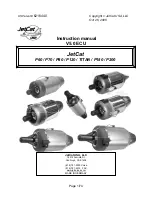
Version 02-09-2020
BG 66
d
Move
Page/Seite
17 / 45
4.6
Betriebsmodus CANopen CO
Das Kommunikationsprotokoll CANopen unterstützt Sie
bei der Vernetzung komplexer Geräte. Neben dem Netz-
werkmanagement und der Geräteüberwachung wird auch
die Kommunikation zwischen verschiedenen Knoten-
punkten unterstützt. Mit der CANopen-Schnittstelle CiA
402 können Parameter einer Bahnkurve wie Positions-,
Geschwindigkeits- und Beschleunigungswerte eingege-
ben werden.
Ansteuerung
Der Motor kann über verschiedene Varianten angesteuert
werden: CiA 402 (IEC 61800-7), Quickstart, Hersteller-
objekte,...
Das Geräteprofil CiA 402 sollte nur genutzt werden, falls
es von der Steuerung schon vorgefertigte Bausteine für
das Geräteprofil CiA 402 gibt (bei Beckhoff z. B. den
NC-Achstyp CANopen CiA 402 oder bei Omron z. B. die
Motion Control der NJ-Serie). Ansonsten wird die Dun-
kermotoren spezifische Ansteuerung empfohlen, da diese
effektiver und einfacher umzusetzen ist.
Quick-Start
Mit den Quick-Start Gerätekommandos lässt sich der
Antrieb mit nur einem Befehl starten. Damit wird der
Programmieraufwand auf ein Minimum reduziert und eine
wesentlich schnellere und effizientere Implementation des
Antriebs garantiert. Weiterhin verringert sich sowohl das
Steuerungsprogramm als auch die Buslast. Der Funk-
tionsbaustein ist sozusagen im Antrieb integriert.
Mit Quick-Start können alle Funktionen mit nur einem Be-
fehl bestehend aus drei Parametern abgedeckt werden:
»
Quick-Start Gerätekommando.
»
Quick-Start Sollwert 0.
»
Quick-Start Sollwert 1.
Insbesondere kann man diese drei Parameter in einem
PDO zusammenfassen, so dass sich der Antrieb mit nur
einem PDO ansteuern lässt.
Folgende Kommandos sind beispielsweise möglich:
»
Kombinierte Stoppkommandos (Antrieb zunächst aktiv
bremsen, dann automatisch Leistungsstufe sperren).
»
Stromgeregelte Betriebsart mit Vorgabe Sollstrom.
»
Drehzahlbetriebsart mit Vorgabe Solldrehzahl.
»
Absolute und relative Positionierung mit Vorgabe Soll-
drehzahl und Zielposition.
»
Start Referenzfahrt.
»
Verschiedene Stoppkommandos.
»
Fehler quittieren.
»
Leistungsstufe sperren und freigeben.
»
Ändern der Beschleunigungsrampen.
4.6
Operating Mode CANopen CO
The communication protocol CANopen supports you
in linking complex devices. In addition to the network
management and device monitoring, communication
between various nodes is supported as well. The
CANopen interface CiA 402 can be used to enter para-
meters of a path curve, such as position, speed and
acceleration values.
Control
There are several variants for controlling the motor: CiA
402 (IEC 61800-7), quick start, manufacturer‘s objects,...
The device profile CiA 402 should only be used if the con-
trol system already has any pre-installed components for
the device profile CiA 402 (for Beckhoff, e.g., the NC axis
type CANopen CiA 402 or for Omron, e.g., the Motion
Control of the NJ series). Otherwise, the Dunkermotoren-
specific control is recommended, since it is more effective
and easier to implement.
Quick start
The quick start device commands start the drive unit with
a single command. This minimises the programming effort
to a minimum and guarantees much faster and more
efficient implementation of the drive unit. The control pro-
gram and the bus load both reduce as well. The function
component is virtually integrated in the drive unit.
Quick start can cover all functions with a single command
comprising of three parameters:
»
Quick start device command.
»
Quick start nominal value 0.
»
Quick start nominal value 1.
In particular, these three parameters can be summarised
in one PDO so that the drive unit can be controlled with a
single PDO.
The following commands are possible, for example:
»
Combined stop commands (first actively brake the
drive unit, then lock the power stage automatically).
»
Current-controlled operating mode with specification
for nominal current.
»
Revolutions operating mode with specification of
nominal speed.
»
Absolute and relative positioning with specification of
nominal speed and target position.
»
Start of reference run.
»
Various stop commands.
»
Acknowledge failure.
»
Locking and releasing the power stage.
»
Changing the acceleration ramps.
















































